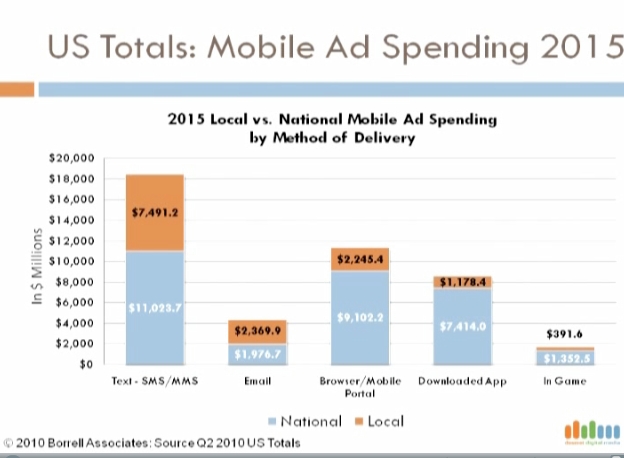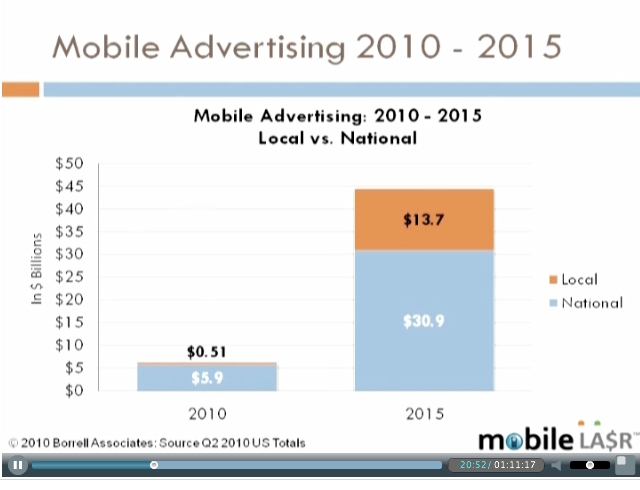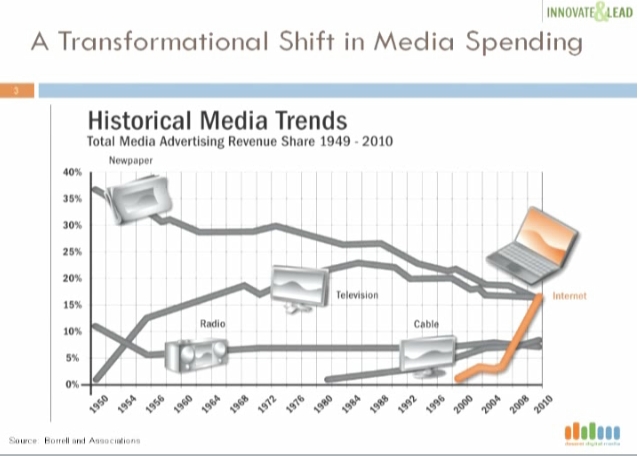Crash Course on Mobile Advertising
Take Aways from the 2010 Borrell Local Mobile Advertising Conference
As audience attention shifts from computers to mobile devices, advertisers will follow. Brush up on your knowledge with 15 things to know about mobile advertising today.
1. There are three main kinds of mobile advertising: Display advertising, SMS text messaging and search.
• Display ads are most like traditional internet ads; served on content or applications. Because the ads are apt to be small, they need to be a direct call to action and link to a mobile landing page (see #2 for landing page options).
• Search results are also a key product. This includes directories and other SEM products mobilized for search and apps for searchable discounts. This end of the business is increasingly important as people conduct last minute searches via mobile immediately before a purchase (or even in store).
• SMS texting is significantly different. Text-messaging is relatively old technology that has also taken on a new life as businesses learn how to text offers to customers. One reason is that unlike display ads, texting is the same on all phones. It also encourage buys of online or offline advertising, from display ad to billboards, to either get people to text immediately or opt in to receive discounts. Businesses building their own opt in lists, called customer loyalty programs, ask people to text a short code (a number or word shorter than a full phone number) to recieve a discount that is "texted back" to them. One additional text back is allowed to "collect" a second opt'in, "would you like to recieve notifications in the future," required to sending additional offers. Unlike e-mail, the second opt-in is heavily policed.
Some companies are also selling apps as advertising, but that is usually at the national level.
2. Tracking is a must. Mobile display ads also offer a variety different conversion-tracking mechanisms.
Because of the limited space and the nature of the way phones are used, tracking is a part of almost all mobile campaigns. There are a number of new conversion mechanisms that act differently on a mobile device:
•Click-to-call. An example of this is a credit union that offers to "Pay $500 if we can't lower your rate" on an auto loan, with a click to call that goes directly to a loan agent, in this case study.
•Click to find an address and/or map while en route. In the above case study, the credit union had five branches and considered a "click for a branch near you" to count as a conversion.
•Click to a mobile landing page or web site - these pages now must be optimized for mobile to avoid scrolling or "pinching" in the case of smart phones, and include more options such as click to call, to find directions, or fill out a form.
•Click to download an app, on smart phones. This is usually reserved for media companies' own apps or national advertisers. An increasingly common use is for media to offer a searchable mobile coupon app through a technology partner and to promote this app in the remnant display space.
•Click to register for an email list or fill out a form. Almost any data-collection will also work on mobile, so businesses with email lists can use the additional mobile audience to build their email database as well as text.
•Text to receive a special offer. One of our favorite case studies is the Text Bang campaign to receive a discount on fireworks. Those ads were run on billboards, but mobile ads that prompt texting are even more effective, since people are already on their phones.
•Showing mobile discounts at the store. Increasingly the phone is both coupon and wallet.
In general, click-through rates on mobile devices are two to three times higher than on personal computers, and highest on iPads. The immediacy of phones - carried while en route - means that maps are often used and conversions to sales are higher. Click through rates are, in fact, two to three times those of personal computers.
3. Selling mobile display has a slow start, big future. Media just starting to sell mobile are finding that mobile display has more initial resistance from local advertisers than banner sales on computers, but is superior in almost every way once advertisers have tried it. Best practices for starting to sell mobile display include showing the advertiser:
• Higher SOV available now to early adapters (often 100%!)
• Lack of competitors in the space
• Novelty value of mobile ads
• More personal space and closer to the purchase point
• Higher click through rates
• Younger, affluent audience in the case of smart phones
• Key means of reaching Hispanic market, which over-indexes
• Mobile as additional reach, stats on internet usage via mobile
• Need to reach people when and where they are consuming information means including mobile
While slow to market, some large regional businesses have already heavily moved into mobile and enjoy these advantages. Larger text alert services (in the one million plus range) are getting sponsorship buys in the $8000 a month range from hospitals, banks and national advertisers buying locallly, such as McDonalds.
Mobile means immediacy. The phone is on the body 16 hours a day and people are accessing it while they are in transit, and can always take an action such as clicking to call, or simply driving to the destination they see in a map. In this respect it is more like radio. This is a great opportunity to day part or otherwise target to capture people as they are on the move and making decisions.
4. This is a highly personal medium, so text-marketing has dangers. While you can get away with "average" for an email offer or a display ad, text message offers have to be exceptional. People are annoyed by messages on their phones that they don't want. Even with double opt'ins, very specific targeting by interest and geography is a best practice. A bad offer can get hundreds of opt-outs- and damage the brand - in a few minutes.
5. Maps on ads increase click-throughs. Google's study show that having a small map on a mobile ad increases response to search ads by 7%. Space is scarce, so you won't be able to put a map in a mobile display ad unless it "opens up", but you can put maps on the mobile landing page or at least link to a mobilty optimized map. Google uses a blue balloon that opens up to map.
To understand the importance of maps on phone, consider how many people conduct a search "at the bottem of the sales funnel," just before making a local purchase. In fact, 33% of all Google searches include a local geographical term. Phones are even closer to the point of transaction.
6. Click-to-call. Don't even think about it, this should be part of almost all ads, the ad is already on a phone. Ask whether the provider provides tracking on the click to call - oddly many of the best ones do not - so you can include this in your campaign tracking. One media rep had to buy a prepay phone to track leads for an automotive client who had heavily invested, simply as a means of tracking a click-to-call mobile campaign. The trend however is for tracking dashboards that cover an increasing array of products and platforms, and will eventually to be controled by the advertiser.
7. Browsers are winning the war over apps. If your company does not yet have an app, this is a comforting statistic. Still, it doesn't mean that apps are not important. Apps compose about 17 to 30% of the mobile internet audience, depending on what is being measured. Media who have launched apps say that the audience is more loyal, and accessing the apps on a regular basis (after all, its an icon on their phone). It also tends to be a young and affluent audience, ie the smart phone crowd. Ads on apps also tend to have higher conversion rates. In the long run, however, apps will largely be replaced by HTML5.
8. The iPad is qualitativeley different. We're not sure how quite yet, but love word and eyes glazing when iPad owners talk about their device is just part of a new phenomenon changing the mobile landscape. These large readers act more like the newspapers than computers. The audience likes its news packaged with extra functions, has a greater wilingness to pay and usage is more at home than at the office - studies are showing that people are reading the devices in bed - and while traveling. Early studies are showing conversion rates and CPM are also double or triple that of phones, although it is not clearly known whether this is simply the novelty effect.
9. Too many devices is a chronic problem of the industry that will not change. One large media companies at the Borrell Mobile convention has built almost 50 application and waps, but small companies will need partners to build across the mlutiutde - we are talking hundreds - of proliferating devices. Key reasons is that the carriers all want new and different phones uniquely to their brand, in their stories, and updated often. This is another reason that texting, which requires no special platform, is a high value marketing tool.
However, keep in mind that because of large number of people who access the internet online, most small businesses will run out of budget before they buy up all the inventory on just one carrier.
10. Mobile offers and coupons are growing as the phone becomes both coupon and wallet.
The coupon market seems made for mobile devices. Mobility adds a huge convenience factor by not requiring people to "go home and print" a coupon or deal they want.
11. Opt-in lists for texting is a complex mechanism.
As mentioned earlier, texting campaigns are the fastest growing are of mobile marketing. Here are some things to know about it:
• Opt in lists take a long time to build. A master e-mail marketer, Scott P's Pizza, has 100,000 email names that yields $1,000 in sales per blast. Even so, with seven stores, it took six months to build a list of 1900 names who opt in for texted discounts. So when starting to sell text-based programs, set expectations for clients low and allow time for the list to develop, says Nancy Lane, president of Suburban Newspaper Association.
• Who owns the list, the media, the provider, the advertiser, or? The advertiser generally owns their list, but, ultimately no one really fully controls it. If the media company changes providers, the advertiser needs to request that its customers "re-opt'in" on the new provider. Contacts cannot simply be exported. Similarily, neither the vendor nor the media company can keep or aggregate the opt'in lists they have serviced for specific advertisers. Some companies, such as Shooger, have an app that allows customer an option to click to see more aggregated offers. Deseret Media featured here, has also developed a searchable coupon app.
•Opt-in lists for text offers have very high conversion rates. We've heard conversion ranges for text campaigns of 25% or more for these double opt'in lists. However, plan to send just one per week, maximum.
• Allow for short term targeting. One way to use text messaging is for very short term and nearby offers. The opt in can ask "let me know offers for food when I am in the area". Since texts have an immediacy, timing them sensitively, say, a lunch special sent out an hour before lunch or a Happy Hours texted at 4:30 p.m. They don't last, so with one text a week, make it count! Some business marketers prefer email or longer term offers and keep their best and most timely offers for text-based campaigns.
12. More ways to target. For display advertising there are all kinds of ways to target on mobile; by carrier, by content, by area code as well as triangulation to geo-target current location. Click-throughs respond immediately to targeting and advertisers are willing to pay more, so make this a priority to develop targeting options.
13. Package everything. The more products and services, the greater the risk that advertisers will suffer paralysis from analysis. So make it simple for advertisers. Have bundles of products in small, medium and large groupings, and which match commonly requested audiences. Think of coming up with a great idea or offer, and then using a bundle of distribution strategies to drive the concept. Valpak is using packaging to integrate a number of complex products for disparate groups of franchisees around the country, making it easier for them to transition advertisers to new products.
15. Viva the dashboard. More companies are realize the value of having dashboards that not only sales people, but also clients can see and operate to change offers and track conversion rates. Many technology partners are getting very good at supplying these, although many still do not allow multiple permissions such as access at the individual advertiser level, and integration between display ads and texting services. We'll keep our eye out for ones that do.
Look for more case studies in our e-mail alerts.

The author, Alisa Cromer is publisher of a variety of online media, including LocalMediaInsider and MediaExecsTech, developed while on a fellowship with the Reynolds Journalism Institute and which has evolved into a leading marketing company for media technology start-ups. In 2017 she founded Worldstir.com, an online magazine, to showcases perspectives from around the world on new topic each month, translated from and to the top five languages in the world.











